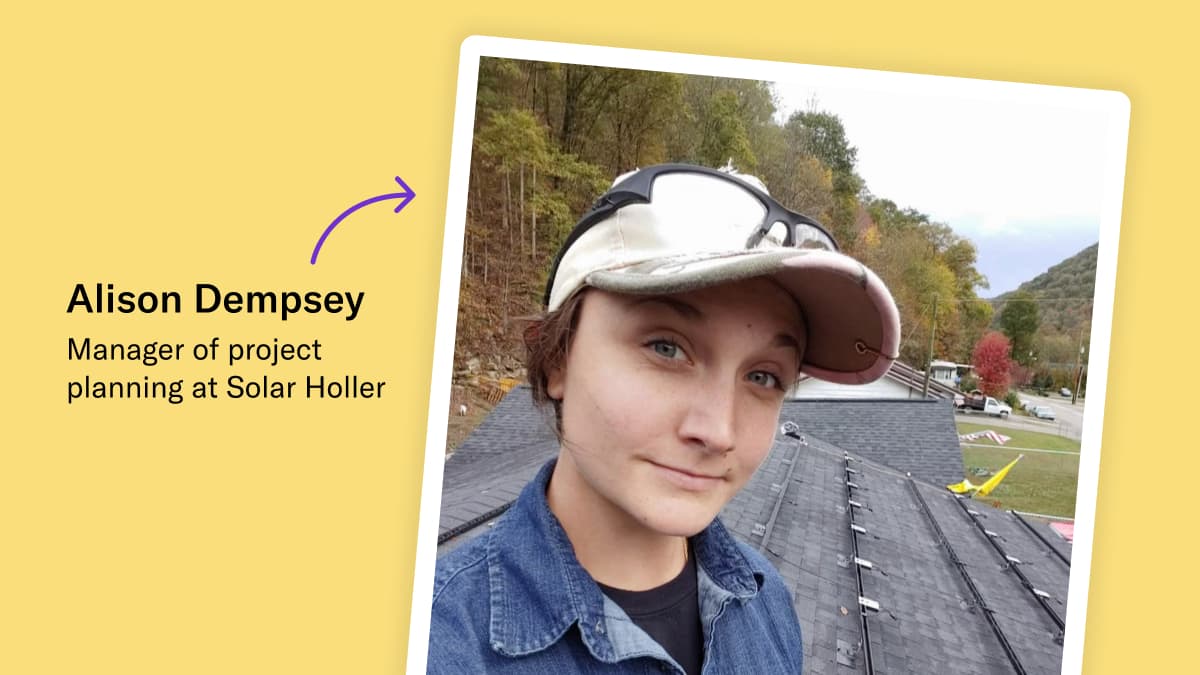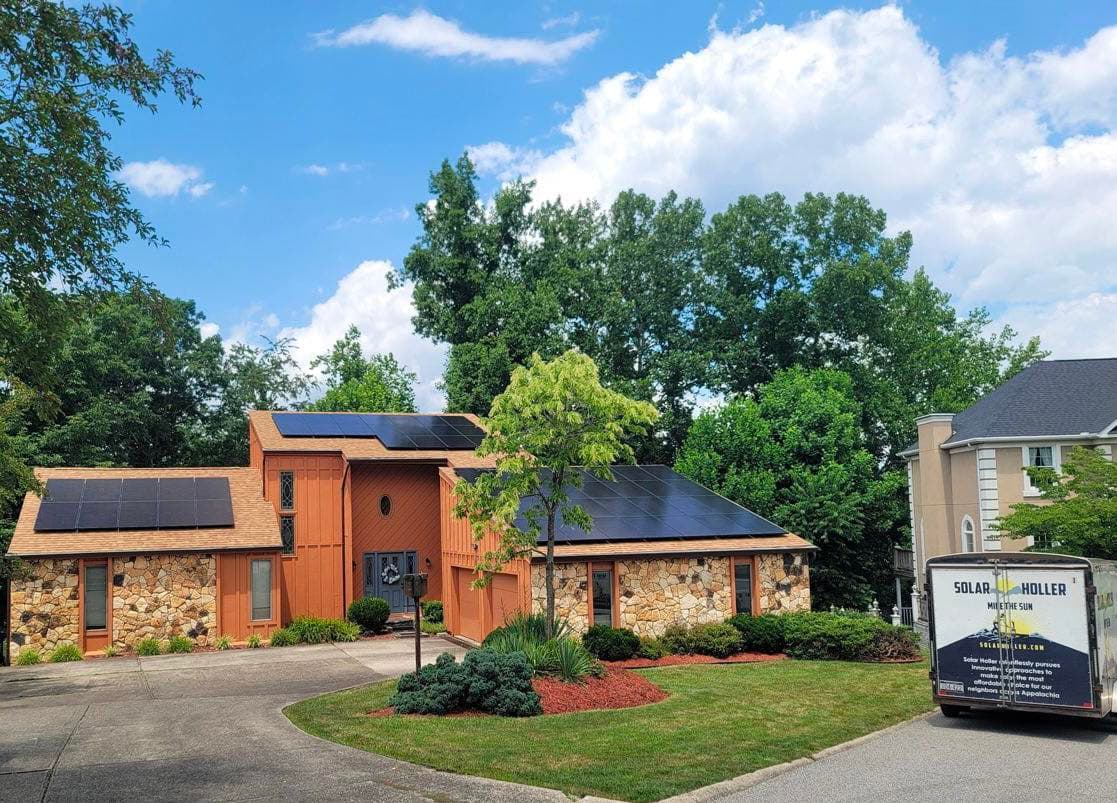How working in solar energy changed one mom’s life for the better
Alison Dempsey has overseen more than 2,000 installs during her time at Solar Holler, West Virginia’s largest solar panel installation company.

Alison Dempsey had scrolled past the social media ads in her feed plenty of times, skipping over the invitation to apply for a local, all-expenses paid training program to gain skills in construction and skilled trades.
Dempsey was no stranger to construction sites — and even traveled around the country for a few years after high school, tagging along with her brothers while they welded and built gas pipelines. But she never really considered it as a job path for herself. Instead, she steadily worked her way up through the ranks to a manager job at Petco while living in her small hometown at the far western edge of West Virginia, near the border with Ohio and Kentucky.
Then, a month after her son Jackson’s birth, he was diagnosed with cystic fibrosis — a progressive genetic disorder that affects the lungs and other organs. With her health insurance coming through her husband, Dempsey realized she wanted a career path that would guarantee a stable financial base and medical coverage, no matter what the future of their relationship held.
“He was making the brunt of the money. I was making decent money for working retail, but he had the insurance. I started to realize, if this isn't going to work out, then I definitely need to be capable of more, right? I can't support myself and my child working where I'm at and doing what I'm doing,” Dempsey said.
So when the ads came up again advertising the West Virginia women work program — a tuition-free, 12-week course that offers hands-on training in skills like plumbing, electrical work, and carpentry — to candidates with no prior experience, Dempsey was all in.
“They were taking applications for the fall course … I was like, You know what? What could it hurt?” she said. “It’s worth a shot.”
‘I started to explore some of my strengths’
Dempsey was called in for an interview and accepted into the program. She and a dozen other women gathered all day each weekday for three months — learning how to build a shed, weld, and follow a wiring schematic to install lighting.
“I started to explore some of my strengths and really find some confidence, which is one of the biggest things that I got from that class, and started to really kind of push myself and just figure out what I wanted to do next,” Dempsey said.
When she wasn’t in classes, she was working nights and weekends, and caring for her son. She was inspired by her classmates, many of whom had similar life experiences and backgrounds — as well as the alumni who came back to mentor them, and talk about their successful careers in engineering or as electricians.
“A lot of other women are coming from other similar situations, they have kids they want to provide for, they’re getting out of an abusive relationship,” Dempsey said, “To be in a group of women who are all similarly challenged and trying to make better for themselves, and do some of these things for the very first time and realize, ‘hey, I can actually do this’, was super cool.”
Programs like West Virginia Women Work are looking to fill a nationwide gap in construction and skilled trades workers. There were close to 280,000 unfilled construction jobs at the end of 2024 — and with roughly 40 percent of current workers in construction trades aged 45 or older, that’s on track to get worse as workers head into retirement, according to the Bureau of Labor Statistics.
“ I was just going for it. I was taking instruction, and I was executing it ... nobody made me feel like I didn’t belong there.”
— Alison Dempsey
As part of the program, Dempsey had to shadow construction crews on site. Some former graduates raved about their jobs at the solar panel installation company Solar Holler, a now decade-old company that is looking to rebuild the Appalachian economy and supply clean energy to those who need it most in West Virginia, Kentucky, Ohio, and Virginia.
The company, which currently has close to 100 full time staff and interns and is unionized through the International Brotherhood of Electrical Workers (IBEW) and the Carpenter’s Union, was the first in West Virginia to offer on-the-job training and apprenticeship programs to skill up its workers.
Dempsey, an avid hiker, had always had a love of the outdoors — and asked to tag along with one of Solar Holler’s crews.
She arrived on site on a cold, rainy October day, and met up with the all-male crew, which included two new hires in training. As they headed up to the roof and got guidance from the crew lead on how to lay solar panels and connect them, Dempsey said all of her training and experience kicked into full gear.
“I'm paying attention to what he's walking them through... It was making sense, and I was just going for it. I was taking instruction, and I was executing it,” she remembers, “They were nothing but respectful to me, nobody made me feel like I didn’t belong there.”
She applied for an installation job as soon as she got home that night.
To her surprise, when she spoke with the interview team, they encouraged her to apply for a more senior position as a project manager — because of her experience in management from her retail work. She said she was initially hesitant, feeling a responsibility to start out by being more hands-on in the field, but soon realized the flexibility would be a huge boon for her to care for her son.
“I ended up taking the job, and I’m so glad I did,” she said.

The median salary of a solar photovoltaic technician in the U.S. is $60,000 a year, and the median salary for a solar installation project manager nationwide can reach $104,000 a year, according to the job site Glassdoor.
There are more than 1.1 million jobs expected to be created as a direct result of the electrification boom over the next decade, according to Rewiring America’s 2024 Workforce report.
“We can afford that now”
Dempsey hit the ground running in her role, getting up to speed on the terminology, visiting installation sites, communicating with other project managers and crews, poring over schematics, and learning to manage supply flows and prevent bottlenecks.
She also dove into her role interacting with customers, even giving out her personal cellphone number for their questions and concerns in the company’s early days.
Years later, she said she still gets text messages on her phone from customers who give her updates on how they — and their solar panels — are doing.
“I've had people that have messaged me and been so heartfelt,” she said, “they've paid this set payment instead of whatever is happening because they're not paying for electricity anymore. They're just paying their solar off at this point.”
“People are just over the moon about it,” she added. “It’s really a life-changing thing to be able to budget, to be able to prepare.”
Dempsey said that’s especially true in light of the volatility of energy prices, particularly during a cold snap like the recent one that swept the area.
“You don’t know what the rates are going to be any given month — then you have a bad winter, when you’re running your heat extra, then all of a sudden you’ve got a $800 bill,” she said.
Customers said after they install solar, they feel a freedom in being able to move beyond fretting over their day-to-day energy bills, and instead plan for the future.
“They were like, you know, because we were able to budget for this, we're looking at taking a cruise this coming summer, because we know that we can afford that now,” she said.
The benefits also extend past the financial ones. Customers often send Dempsey a screenshot of how much clean energy their panels have generated, thanks to a monitoring app in the Solar Holler system.
“it matters to them that they feel like they're making a difference,” she said, adding that the enthusiasm spreads quickly in the form of word-of-mouth referrals.
“Suddenly their sisters and their neighbors and like their parents are all, ‘hey, we want a system too.” she said, “it's really contagious.”
Want to know if solar is right for your home? Check out homes.rewiringamerica.org to get started.
